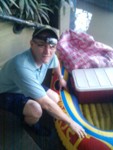THE ripples keep spreading out.
Who would have thought that a few drops of rain on a drought-wracked country would have so many ramifications?
Of course, those few drops turned into a torrent in Queensland, New South Wales and later Victoria, as well as Tasmania and South Australia.
Wayne Swan, the Federal Treasurer — a Queenslander — has proclaimed that the floods are the most expensive natural disaster that Australia has ever seen. He says they will inflict “significant damage” on the economy and government finances.
Prime Minister Julia Gillard has not ruled out a flood levy, despite the $100 million already donated to the Queensland Premier’s Flood Relief Fund.
The floods are truly a national disaster of the highest order. If Kevin Rudd were still Prime Minister he could be tempted to call it “the greatest moral challenge of our time”.
As quiet streams were turned into raging torrents that smashed all before them, reporters and commentators were using language such as “apocalypse”, “war zone”, “biblical proportions”, “one in 200-year flood”, “unprecedented” and “never before seen”.
Many lives have been lost, but a quick review of the footage of the floods confirms that we have been extremely lucky not to have lost more.
In Brisbane, despite our new dam holding more than six times the volume of Sydney Harbour, it was overwhelmed when, on just one day, more water than Sydney Harbour holds flowed directly into it. The Brisbane River once again broke its banks.
Many general practices were inundated. GPs were finding that if their practices did not go under, then their houses or the houses of their staff did.
We were operating on a skeleton staff ourselves for several days, but many patients did not or could not come to us either.
Week two of the floods was punctuated by clean-up issues.
Large numbers of people were presenting for treatment of cuts, abrasions and scratches sustained around filthy floodwaters or stinking mud.
Thankfully, our water supply was not compromised and truckload after truckload of rubbish was carted away, staving off the huge potential for more infectious disease.
We expect mosquito-borne diseases to increase exponentially.
I saw my first case of Barmah Forest virus last week. And the fevers are still to come — Ross River, and perhaps Dengue.
Murray Valley encephalitis may even begin to show up. Meliodosis from contaminated soil is a possibility, as well as many other diseases not normally seen in south-east Queensland.
Mental wellness is the big sleeper — with hundred of thousands of people directly affected, and millions indirectly affected.
And we cannot forget our children who saw those distressing images on TV over and over and over again.
Getting normal health services up and running to meet demand is going to take time.
Queensland’s largest hospital (the Royal Brisbane and Women’s Hospital) had to cancel all elective surgery and specialist outpatient appointments because of the floods crisis, and when last checked had not restarted.
Elective surgery and specialist outpatients’ appointments were also cancelled at Caboolture, Toowoomba, Ipswich, Oakey and Nambour.
Cancellations will add to the already long waiting lists with ramifications that will be felt for months to come.
There simply is no spare capacity to catch up. In fact, they will never catch up!
Just as we have seen the worst in our weather, we have seen the best in our community, with volunteers coming out to provide a hard day’s work in difficult conditions to help perfect strangers.
Individuals and businesses dug deep. The Premier’s Fund was originally targeting $15 million. It has just surpassed $100 million.
All of us involved in the floods say “thank you” to our fellow Australians. Regardless of race, colour or creed, we are all Australians and we are here to help each other.
The ripples from this flood will be felt for months, if not years, to come.
Dr Steve Hambleton is the vice-president of the Australian Medical Association and a GP in the Brisbane suburb of Kedron. His surgery and home in Brisbane were not flooded but he was involved in helping friends who were affected with the clean up.
Posted 24 January 2011

 more_vert
more_vert
good educational study.